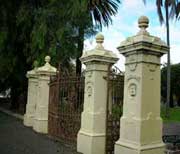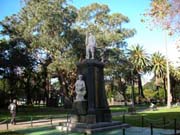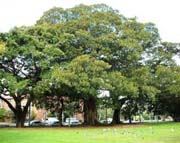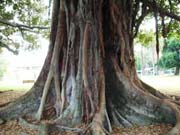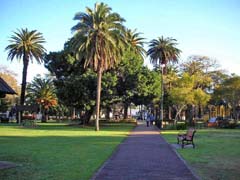Some reflections from a regular user of Redfern Park
Redfern Park was dedicated in 1891 to the people of Redfern. Its gates on Redfern Street face directly towards modern-day Centrepoint Tower in the heart of Sydney's CBD, about two kilometres to the north.
Location
The park is bounded on the east by Elizabeth Street and on the west by Chalmers Street (late 'Castlereagh' Street). These both used to take traffic all the way to Circular Quay but Elizabeth Street is now one-way south-bound. Castlereagh Street was broken to accommodate Sydney Terminal Central Railway Station in 1926 for the opening of the underground tunnels to Wynyard and St James. In 1932 the Wynyard tunnels were extended to the Sydney Harbour Bridge and North Sydney. The park's westerly border has thus since been known as Chalmers Street where South Sydney Leagues Club and the Actors Equity (MEAA) building can be found.
The Cenotaph
The Cenotaph has 112 names of young soldiers from Redfern who did not return from the First World War. Among the Anglo-Celtic names are six of possible Jewish origin (according to a member of Central Synagogue): Horwitz, Joel, Levy, Leslie, Roth and Wise. There is a Byrne and an O'Farrell. This shows how essentially European Redfern was at the turn of that century, still lacking a visible Asian and Lebanese community. Aboriginal Australians only gravitated to Redfern in large numbers in the middle decades of the century according to what I have been told.
Botanical Features
This park has examples of the earliest botanical imports to the colony.
The first fleet stopped at the Canary Islands on the way to their second stop in Brazil. Here some palm seeds or seedlings must have been obtained as Sydney is now scattered with Canary Island Palm trees, including the very ancient specimens in Redfern Park. Some of these are nearing the end of their life spans. Others have apparently been smitten with a degenerative fungus disease causing their early demise.
Fig trees grow in most coastal areas in the South Pacific region with many variations on the theme of complex root systems, waxy leaves and fruit for local bat colonies. A number of quite separate species occur such as Benjamin, Morton Bay, Illawarra (also known as Port Jackson Figs) and Hills (the latter from Noumea). Along Elizabeth Street are found some of the biggest examples of Moreton Bay figs in the city. They have enormous aerial roots, lateral branches and vast curved canopies extending up to 25 metres from the huge trunks.
There is a fine example of the Coral Tree. It is apparently a hybrid between a Queensland native and a South American tree which must be a distant relation from the era before the continental drift separating Antarctica, America and Australia. Happily, it flowers in June when many other species are dormant.
A single enormous 'London' Plane tree is not far from the north-west corner. It is one of the most perfectly formed trees I have ever seen. Its bark is a work of art worthy of any gallery. It is also a sterile trans-Mediterranean hybrid with African roots and a French connection via Marseilles.
Nearby is what I call a flooded gum of which thousands of examples can be found on the plain in Israel / Palestine. Unlike most gums in the Australian bush, it is luxuriant of foliage and almost symmetrical. Country New South Wales would be incomplete without stands of Indian pepper trees along river banks and swampy verges. There is one excellent example with its wafting foliage, next to the old Victorian gates.
There are some old over-tall date palms which look like they could fall with the next storm. And occasionally, they do.
There are a couple of Pacific pines related to the Norfolk, possibly Cookii or Hoope, also rather tall and sky-seeking, seldom symmetrical.
With a magnificent centrally placed bronze fountain and pathways to each corner and vantage, this is a glorious example of Victorian urban architecture. One can even cope with the anachronisms, such as ornate gates but no fence; natives and exotics together. If only modern planners could try to imagine what their work will look like in 100 years rather than three!
